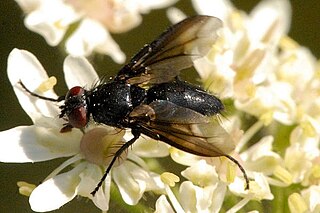
Pierre-Justin-Marie Macquart was a French entomologist specialising in the study of Diptera. He worked on world species as well as European and described many new species.

The Brachyceran infraorder Xylophagomorpha is a small group that consists solely of the family Xylophagidae, which presently contains subfamilies that were sometimes considered to be two small related families. Other obsolete names for members of this family include Exeretonevridae and Heterostomidae.

Syritta is a genus of hoverflies, family Syrphidae.

Xylota is a Holarctic genus of hoverflies similar in structure to the related genera Chalcosyrphus and Brachypalpoides. As the larvae are saprophytic they're usually found in rotting wood. The adult flies are generally associated with woodland and woodland edges and can often be seen running over the upper sides of leaves. Unlike other syrphids the adults of many species rarely visit flowers preferring instead to gather pollen from leaf surfaces. There are over 100 described species of which 12 can be found in Europe. Seven species have been recorded in Britain. Identification of species has been difficult and identifiction by photographs is risky.

Cordyligaster is a genus of bristle flies in the family Tachinidae.

Blera is primarily a North American genus, though there are 3 species from Europe. The genus is characterized by the following characters:

Tropidia is a genus hoverflies, from the family Syrphidae, in the order Diptera.

Scaptia is a genus of horse-fly in the tribe Scionini.

The Milesiini is a large and diverse tribe of hoverflies. They mimic wasps or hornets.

Milesia is a genus of very large hoverflies, which mimic social wasps. For example, the European species Milesia crabroniformis is a convincing mimic of the hornet species Vespa crabro. Milesia are predominantly Palaeotropical in distribution almost entirely Oriental.

Dexiinae is a subfamily of flies in the family Tachinidae.

Dexiini is a tribe of flies in the family Tachinidae.

Elassogaster is a genus of scavenger flies (Diptera) belonging to the family Platystomatidae. They are native to warm regions of Africa, Madagascar, Asia and Australia.
Tabanus fusconervosus is a horse fly in the subfamily Tabaninae, in the order Diptera ("flies").
Hamatabanus carolinensis is a species of horse flies in the family Tabanidae.
Hybomitra lasiophthalma is a species of horse flies in the family Tabanidae.
Anthrax analis is a species of bee fly in the family Bombyliidae. It's a parasitoid whose hosts include Cicindela scutellaris, Cicindela hirticollis, Cicindela marginata, Cicindela punctulata, and Cicindela tranquebarica.
Lepiselaga is a genus of horse flies in the family Tabanidae.
Arcuavena is a genus of flies in the family Stratiomyidae.
Chiromyza is a genus of flies in the family Stratiomyidae.











